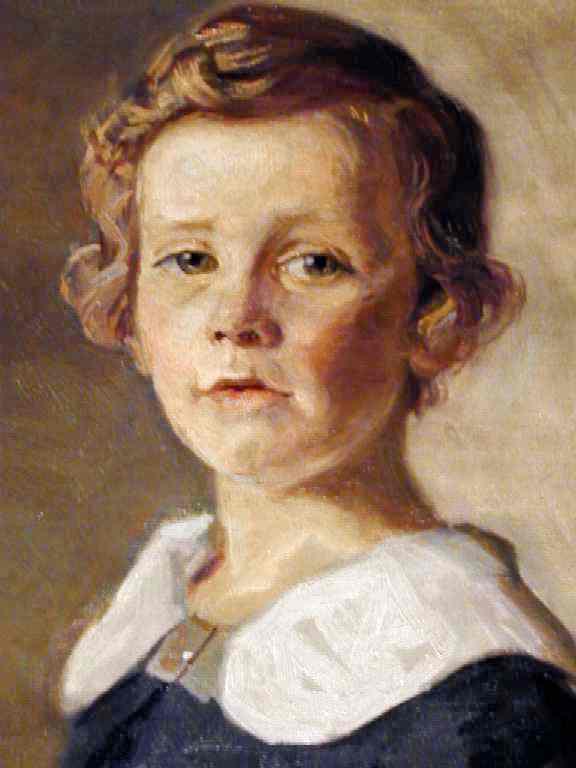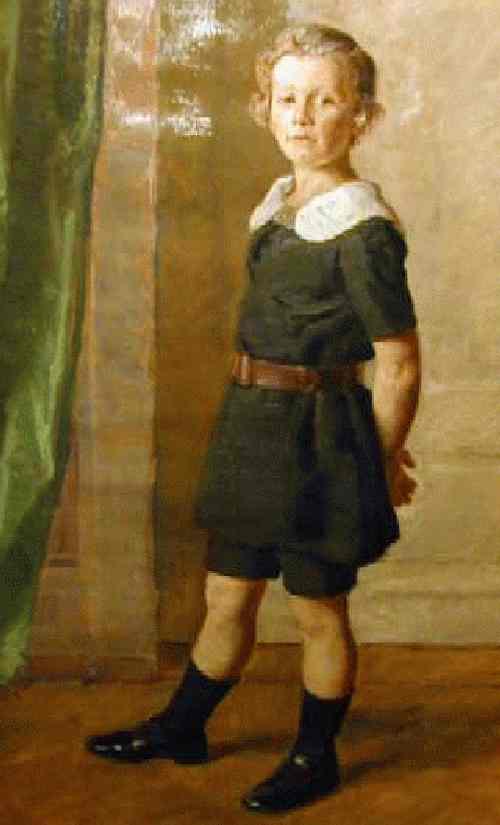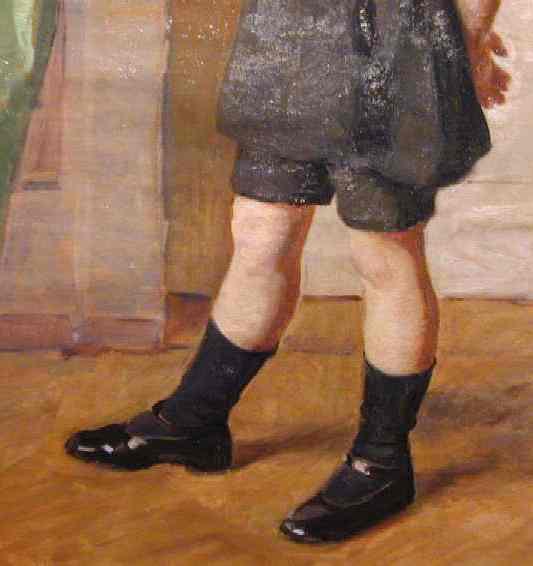
Figure 1.--This Danish boy's portrait was painted in 1908. Notice the curls, but not long ringlets that American boys might still wear. The wide white collar has an unusual separation.


Figure 1.--This Danish boy's portrait was painted in 1908. Notice the curls, but not long ringlets that American boys might still wear. The wide white collar has an unusual separation. |
Georg Seligmann executed some wonderfully detailed portarits with fascinating depictions of late 19th and early 20th century clothing. I unfortunately know nothing about this Danish painter.
Unfortunately I have no information on the painter at this time.
Seligman's active career was from the late 19th century and the early 20th century through the World war I era. This particular portrai was painted in 1908.
I'm not sure how old this boy is, but would guess around 7 years old.
This Danish boy looks to be about 7 years old. He wears a dark green tunic suit with short pants. With it he had black or dark green three-quarter length socks and strap shoes. He wears the typically European belt over his tunic.
The boy in the portrait is not identified.
This Danish boys wears what appear to be natural curls at ear level--well above the shoulders. Ringlets like Americam boys wore were not as popular in Europe and had begun to go out of style by 1908.
There are several notable features to the collar:
Open cut: Most wide collars like this button tightlt to the neck, While this is not an open necked collar, it is cut qite low--well below a normal collar. HBC has noted open collar styles much more commonly in Europe than America.
Width: The collar is very wide, about as wide a plain white collar as boys wore. Some American boys wore larger ruffled collars, but wide plain collars were rarely larger than the one shown here. Notice how the collar completely covers the shoulders.
Separation: The two wings of the collar do not meet. This is very unusual in a boy's colar. There appears to be a tan colored connection, although it is not clear if this is a material conection or some kind of little bow.
Tunic suits were popular outfits for boys at the turn of the century. There were several different styles of tunic suits. Notice that there are no buttons down the front.

Figure 2.--The tunic suit was ione of the most popular styles for turn of the century boys. There were several different styles. |
This tunic suit was worn with short pants. On other suits, above the knee knickers were more common. It was made with short sleeves, rather a new fashion that appeared after the turn of the century. Short pants had appeared at the end of the 19th century and gradually replaced kneepanrs. Notice that these pants are worn well above the knee and without long stockings. Also note the absence of the ornamental buttons at the hem.
European boys might wear several styles such as tunic suits with a belt. These garments did not have belt loops, the belt was purely ornamental. This style was always for boys, it was never worn by girls. The belt had a military look to it and was often employed with juvenile styles like tunics and smocks to make the child look more boy-like.
The boy wears dark half-quarter length stockings. White socks and stockings were becoming more common with strap shoes in the 1900s, but some boys still wore dark socks.
By the turn of the century, boys began to moreccommonly appear in more refined shoe types. It became less common for boys in fancy suits, especially those with kneepants or short pants to wear boot-like or high-top shoes. Strap shoes were particularly popular for boys from affluent families with dressy garments. The strap shoes are a type worn from about the turn of the century to the early 1920s. The strap comes from the back of the shoe rather than the instep.
I'm not sure what material the tunic suit was made from. Perhaps something from Shantung silk. It would have been a light-weight material as this was a summer suit.
One of the advantages of painted portraits is that they reproduce the colors of the clothes worn at the time. Photographs while more detailed are all black and white. This boy's tunic does not look black, but rather a very dark green. Perhaps it is the lighting. Another view makes it look more black or even a dark blue.
HBC has relatively little information on Danish boys' clothes. We believe that they were greatly influenced by German fashion. I think that the short pant tunic suits were more popular in Germany than those with above the knee knicker pants.

Figure 3.--This boy's tunic suit had short pants and were worn with half-length darksocks and black strap shoes. |
Navigate the Boys' Historical Clothing Web Art pages:
[Main artist page]
[Chronology]
[Country]
[Individual Artists]
[Styles]
Navigate the Boys' Historical Clothing Web Site:
[Return to the Main artist page]
[Introduction]
[Activities]
[Biographies]
[Bibliographies]
[Chronology]
[Clothing styles]
[Countries]
[Contributions]
[Boys' Clothing Home]